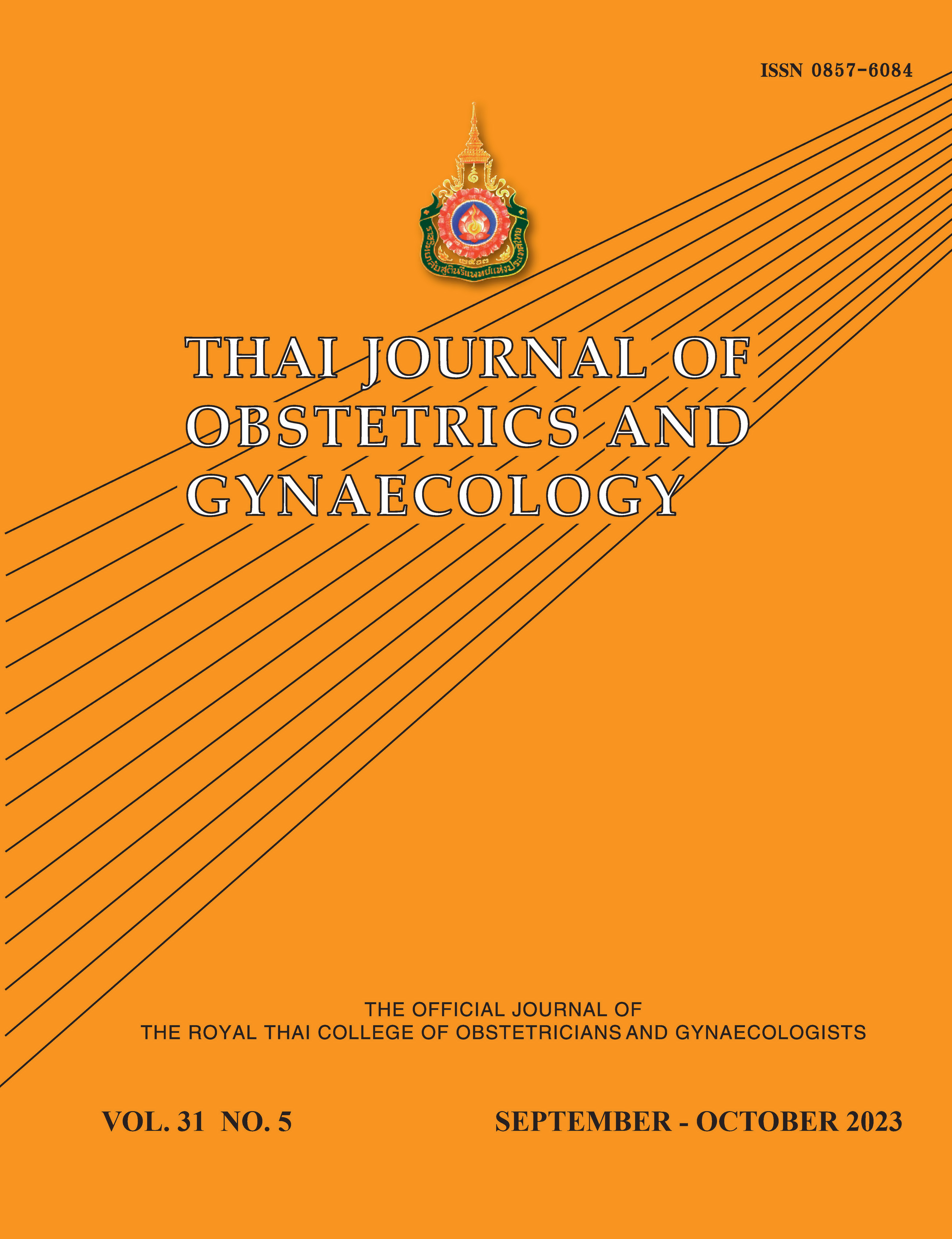A Comparison of the LATCH Scores between Groups of Breastfeeding Women Using and Not Using a Nursing Pillow: A randomized, controlled trial
Main Article Content
Abstract
Objectives: To investigate if the U-shaped nursing pillow can improve the LATCH scores in the postpartum breastfeeding mothers.
Materials and Methods: Postpartum women who had an uncomplicated vaginal delivery and intended to breastfeed were eligible. Mothers who had no contraindications to breastfeeding were randomized into two groups: the nursing-pillow intervention group and the control group. All participants underwent breastfeeding education and training regarding the proper body position. They used a modified cradle technique 2-4 hours postpartum under the guidance of a well-trained breastfeeding nurse. The mothers in the intervention group were instructed to use the U-shaped nursing pillow, size 60 x 60 cm, with 25 - 30 cm thickness during every breastfeeding while they were in the maternity ward. The LATCH scores were assessed at 48 hours postpartum. The primary outcome was a mean difference in the LATCH scores between the groups.
Results: A total of 48 eligible mothers were randomized into two groups: 24 in the nursing-pillow intervention group and 24 in the control group. The LATCH scores of the women who used a nursing pillow were significantly higher. The mean difference was 0.48 (95% confidence interval 0.06-0.90, p = 0.027).
Conclusion: The groups of breastfeeding women using the U-shaped nursing pillow had higher LATCH scores than the control group.
Article Details

This work is licensed under a Creative Commons Attribution-NonCommercial-NoDerivatives 4.0 International License.
References
Eglash A, Montgomery A, Wood J. Breastfeeding. Dis Mon 2008;54:343-411.
Tiruye G, Mesfin F, Geda B, Shiferaw K. Breastfeeding technique and associated factors among breastfeeding mothers in Harar city, Eastern Ethiopia. Int Breastfeed J 2018;13:5.
Altuntas N, Turkyilmaz C, Yildiz H, et al. Validity and reliability of the infant breastfeeding assessment tool, the mother baby assessment tool, and the LATCH scoring system. Breastfeed Med 2014;9:191-5.
Shah MH, Roshan R, Parikh T, Sathe S, Vaidya U, Pandit A. LATCH score at discharge: A predictor of weight gain and exclusive breastfeeding at 6 weeks in term healthy babies. J Pediatr Gastroenterol Nutr 2021;72:e48-e52.
Sowjanya SVNS, Venugopalan L. LATCH score as a predictor of exclusive breastfeeding at 6 weeks postpartum: A prospective cohort study. Breastfeed Med 2018;13:444-9.
Kumar SP, Mooney R, Wieser LJ, Havstad S. The LATCH scoring system and prediction of breastfeeding duration. J Hum Lact 2006;22:391-7.
Tornese G, Ronfani L, Pavan C, Demarini S, Monasta L, Davanzo R. Does the LATCH score assessed in the first 24 hours after delivery predict non-exclusive breastfeeding at hospital discharge?. Breastfeed Med 2012;7:423-30.
Blair A, Cadwell K, Turner-Maffei C, Brimdyr K. The relationship between positioning, the breastfeeding dynamic, the latching process and pain in breastfeeding mothers with sore nipples. Breastfeed Rev 2003;11: 5-10.
Ingram J, Johnson D, Greenwood R. Breastfeeding in Bristol: teaching good positioning, and support from fathers and families. Midwifery 2002;18:87-101.
Milligan RA, Flenniken PM, Pugh LC. Positioning intervention to minimize fatigue in breastfeeding women. Appl Nurs Res 1996;9:67-70.
Holdcroft A, Snidvongs S, Cason A, Doré C J, Berkley KJ. Pain and uterine contractions during breast feeding in the immediate post-partum period increase with parity. Pain 2003;104:589-96.
Klinpikul N, Srichandr P, Poolthong Nuchthana, Thavarungkul N. Factors affecting low back pain during breastfeeding of Thai women. World Academy of Science, Engineering and Technology 2010;72: 289-292.
Sri Widiastuti IAK, Rustina Y, Efendi D. The use of breastfeeding pillow to reduce discomfort for breastfeeding mothers. Pediatr Rep 2020;12(Suppl 1):8702.
Jensen D, Wallace S, Kelsay P. LATCH: a breastfeeding charting system and documentation tool. J Obstet Gynecol Neonatal Nurs 1994;23:27-32.
Sroiwatana S, Puapornpong P. Outcomes of Video-assisted teaching for latching in postpartum women: A randomized controlled trial. Breastfeed Med 2018;13:366-70.
Puapornpong P, Raungrongmorakot K, Laosooksathit W, Hanprasertpong T, Ketsuwan S. Comparison of breastfeeding outcomes between using the laid-back and side-lying breastfeeding positions in mothers delivering by cesarean section: A randomized controlled trial. Breastfeed Med 2017;12:233-7.
Goyal RC, Banginwar AS, Ziyo F, Toweir AA. Breastfeeding practices: positioning, attachment (latch-on) and effective suckling - a hospital-based study in Libya. J Family Community Med 2011;18: 74-9.
Degefa N, Tariku B, Bancha T, et al. Breast feeding practice: Positioning and attachment during breast feeding among lactating mothers visiting health facility in Areka Town, Southern Ethiopia. Int J Pediatr 2019;2019:8969432.
Rani S, Habiba UE, Qazi WA, Tassadaq N. Association of breast feeding positioning with musculoskeletal pain in post partum mothers of Rawalpindi and Islamabad. J Pak Med Assoc 2019;69:564-6.


